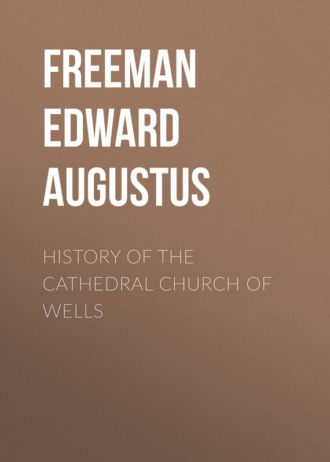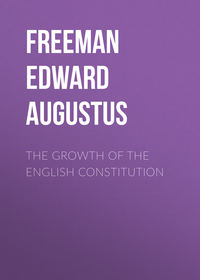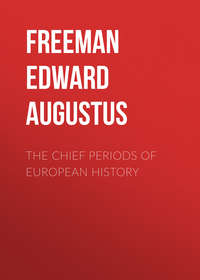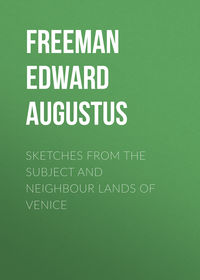 полная версия
полная версияHistory of the Cathedral Church of Wells
Thus, by the end of the thirteenth century, we may look on the church of Wells as at last finished. It still lacked much of that perfection of outline which now belongs to it, and which the next age was finally to give it. Many among that matchless group of surrounding buildings which give Wells its chief charm had not yet arisen. The church itself, with its unfinished towers, must have had a dwarfed and stunted look from every point. The Lady chapel had not yet been reared, with its apse alike to contrast with the great window of the square presbytery above it, and to group in harmony with the more lofty Chapter-house of its own form. The cloister was still of wood. The palace was still undefended by wall or moat. The Vicars' Close and its chain-bridge had not yet been dreamed of. Still the church, alike in its fabric and its constitution, may be looked on as having by this time been brought to perfection. There was still much to add, to improve, and to develope, but all that was essential was there. The church itself, though still lacking somewhat of ideal grace and finish, had been made perfect in all that was absolutely needful. The nave, recast in forms of art such as Ine and Eadward, such as Gisa and Robert, had never dreamed of, with the long range of its arcades and the soaring sweep of its newly-vaulted roof, stood, perfect from western door to rood-loft, ever ready, ever open, to welcome worshippers from city and village, from hill and combe and moor, in every corner of the land which looked to Saint Andrew's as its mother church. The choir, the stalls of the Canons, the throne of the Bishop, were still confined within the narrow space of the crossing; but that narrow space itself gave them a dignity which they lost in later arrangements. For the central lantern, not yet driven to lean on ungainly props, with the rich arcades of its upper stages still open to view, still rose, in all the simple majesty of its four mighty arches, as the noblest of canopies over the choir below. And if the receding vista of the Lady chapel, with that matchless grouping of slender pillars, that no less matchless harmony of colour, was still a thing of the future, yet we have fragments enough to tell us that the older ending of the choir was one rich with the best detail of the thirteenth century,98 and one which perhaps gave greater majesty to the high altar itself, the sole feature of the eastern limb, than any arrangement that can be devised with the present ground-plan. The group of buildings of which the Chapter-house now forms a part was as yet unthought of, but the great octagon itself was already rising; by the end of the century it was perhaps already finished. There it stood, with its central pillar and its surrounding stalls, the many ribs of its vault converging to one centre, typifying, as symbolical writers tell us, the government of each diocesan church, with its many members, clergy and laity, gathering around one common head and father. All this was there already; that is, everything had been done which was needful for the practical perfection of a cathedral church, though something might still be needed to give the fabric its ideal perfection as a work of art. And as with the fabric of the church, so with its constitution. The relations of the original centre of the diocese with its sister or rival churches, in one sense more ancient, in another newer than itself,99 had been finally and peacefully settled. The relations between the Bishop and his Chapter, between the Chapter and its subordinate officers, had been definitely settled also. All the great offices of the church which still exist had been already founded, and those duties had been attached to them which, however much they have been forgotten, still remain the duties of their holders as much now as they were then. In short, the church of Wells, alike in its fabric and in its constitution, was already perfect. The thirteenth century had done its great creative work, and had left to future ages only to improve and develope according to the principles which the thirteenth century had laid down. That is to say, the thirteenth century had done for the local church of Wells what it did for England, what it did for Europe and for the world. It is well to mark how exactly the most striking periods in our local history fall in with the great and decisive epochs in the general history of our country. The church of Wells first arose at the bidding of the first great West-Saxon lawgiver, the prince whose reign fixed for ever that the south-western peninsula of Britain should be, in speech and allegiance, if not wholly in blood, a Teutonic and not a Celtic land. The church received its Bishop at the hands of the great West-Saxon conqueror, at the moment when Wessex finally grew into England, and the first endowment of the Bishoprick of Somersetshire was a gift from the hand of the prince to whom the Northumbrian, the Scot, and the Briton bowed as their father and their lord. The old dynasty passed away and strangers sat on the throne of England; that was the time when a stranger prelate first brought into our church the foreign and novel discipline which he had learned in his own land beyond the sea. And yet, with strangers alike on the royal throne of England and in the episcopal chair of Wells, the ancient fabric, the church of native Kings and saints and heroes, still lived on. Through the reigns of the Norman and the Angevin the ancient fabric still survived as a witness that England and her Church, conquered as they were, still preserved their national being, and would one day arise to wrest their ancient freedom from the hands of their conquerors. That ancient fabric still lived on into days when its witness was no longer needed, to days when England had won her conquerors to her heart, and had changed the sons of her oppressors into the foremost champions of her freedom. A Prelate who had suffered banishment at the hands of John, whose name stands subscribed to the Great Charter of our rights, might venture to sweep away the still abiding monument which told of the older freedom of the days of Ine and Eadward. And, even before his time, we may see how the darker and brighter days of the church of Wells coincided with the darker and brighter days of England. It was during the blackest night of oppression, in the days of the tyrant Rufus, that the name of our church was for a moment wiped out from the roll of Bishopricks, and that its ministers were reduced to beggary by the arbitrary violence of a foreign Bishop. The wrong was redressed in days which, if days of sorrow and conflict, were still days of hope. If the fabric of the church was renewed and strengthened during the civil wars of Stephen, its constitution was finally settled and confirmed when peace and order returned under the sway of the great Henry. And next came the great age of all, the age which, in its creative and in its destructive power, was to leave its mark on every land from one end of heaven to the other. Time would fail to tell of all the mighty men and mighty deeds which are crowded more thickly into the age of Innocent and Frederick, the age of Saint Ferdinand and Saint Lewis, the age of Bacon and Dante, the age in distant lands of the first Mongol and the first Ottoman invaders, than into almost any other equal space in the world's history. Throughout the world destruction and creation were marching side by side; old systems were falling, new systems were rising. But it was in England alone that the new and the old could be worked together into harmony, that the age which elsewhere was an age of destruction and of creation could become simply an age of reform and restoration, an age which put new life into old names and old traditions, and made England England once again. We see the sons of the soil, of whatever blood, alike the children of the conquerors and the children of the conquered, rising in their strength to put a bridle on the tyranny of Popes and Kings, to break the yoke of the stranger, and to win the land back once more for its own children. Then it was that our tongue, our laws, our constitution, assumed those shapes which the six ages that have followed have had only to improve in detail. It was the age of Stephen Langton and Robert Fitzwalter, of Robert Grosseteste and Simon of Montfort, of Roger Bigod and Humfrey Bohun, and of the King from whom they won our freedom. And we in this place may add to the list the name of our local worthy, foremost in local honour and not without his share in the general history of our land, the rebuilder of the fabric of our church, the final lawgiver of its constitution, the honoured name of Jocelin of Wells. As it was throughout all England, so it was in our little city at the foot of Mendip. The older state of things was passing into a newer by a process of gradual and peaceful change and developement. And as throughout all England Englishmen were rising against foreign influence in every shape, so here too it was no stranger from Tours or Lüttich, but a true son of the soil, a native of the kingdom, of the shire, of the city itself, bearing the name of the city as his distinctive surname, to whom fell the great work of calling the fabric of the church into a new being, and of putting the finishing stroke to its ecclesiastical constitution. The local chronicler says with truth that there was none such before him and none such after him.100 Our local history contains earlier and later names which must ever claim our reverence, Beckington, Robert, Gisa himself. But no name of Canon or Dean or Bishop can dwell in the hearts of the men of Wells and Somersetshire like the man of their own shire and their own city who gave that city its greatest and most lasting ornament. He went to his rest and his works followed him; his name and his honour still abideth. Ruthless hands had, even three hundred years back, "monstrously defaced" his marble tomb within his own choir.101 But he is one of those who need not a marble tomb to enshrine their memory. Benefactors of lesser fame may need their graven figures, their epitaphs of brass or alabaster; of Jocelin of Wells we may truly say —
"Si monumentum requiris, circumspice."LECTURE III
I have in my former lectures carried the history both of the fabric and the foundation of the church of Wells to the time of Jocelin, and somewhat later. The thirteenth century, the great creative century of later English history, brought both fabric and foundation to a state, if not of ideal, at least of essential perfection. We now come to two centuries which found much to improve and to enlarge, but which had no need, like their predecessors, to begin afresh from the beginning. Jocelin, we may say, was the last of the line of great innovators for good and for evil, the line formed by Ine and Eadward and Gisa and John de Villulâ and Robert. We now come to what we may call quieter times. One thing to be noticed is that by this time the work of John de Villulâ, the degradation of Wells and exaltation of Bath, has been pretty well reversed. Roger, the successor of Jocelin, may be called the last Bath Bishop. In his election Bath made its last effort. On Jocelin's death the monks of Bath, contrary to the agreement which had been made, ventured to make an election without joining with the Canons of Wells. The story is very characteristic of the reign of Henry the Third. The Pope and the King joined together to do an illegal act to the prejudice of Englishmen. The monks of Bath got their congé d'élire from the King; then they elected in this irregular way; the elect went to the Pope, Innocent the Fourth, who, glad no doubt of such an opportunity, took no heed to the appeal of the Wells Chapter, conferred the Bishoprick on Roger by his own authority, bargaining that the preferment which he vacated, the Precentorship of Salisbury, should be given to his own nephew. The new Bishop was consecrated at Rome, and the temporalities were restored to him by the King.102 This is a sort of thing which could hardly have happened at any time earlier or later. Both in earlier and in later times we suffered a good deal at the hands of both Kings and Popes, but Henry the Third was the only King who habitually conspired with the Pope against his own people. It really adds to the shamelessness of the whole story that, when Innocent had gained his personal point, when he had established the precedent that the Pope might if he pleased appoint to an English Bishoprick, when he had further established his own kinsman in an English living, he then was ready enough to confirm the former agreement, and to decree that the rights of the Chapter of Wells in the election of the Bishop should be observed for the future.103 Roger also made up what he could to the Wells Chapter by the grant of various advantages.104 He did not, however, think good to choose his last resting-place among them. He was the last of our Bishops who was buried at Bath. This marks the time when Wells once more became the real home of the Bishoprick, though Bath still retained its precedence in the episcopal title. And it was doubtless from this time that that comparative neglect of the church of Bath began which ended, as I have already said, in its falling into a state of decay verging on ruin.
During the time that followed I need not go through every Bishop in succession, as several Bishops seem to have had very little to do with the fabric. William Button the First, who was Bishop from 1247 to 1264, was chiefly remarkable for a practice which we certainly have not seen among us for some time past, but of which the traces still linger. In his day all the chief places of the church were filled with the Bishop's own kinsfolk. It was no doubt a most comfortable family party when the Bishop was surrounded by a Dean, Precentor, Treasurer, Archdeacon, and Provost, all of them his own brothers and nephews.105 Yet mark that, though the fact of being the kinsman of a Bishop does not prove a man to be fit for high preferment, it does not prove him to be unfit. One of the Buttons, William the Second, first Archdeacon and afterwards Bishop from 1267 to 1274, was looked on as the holiest Prelate of his time, and after his death miracles were held to be worked at his tomb.106 So they were said to be at the tomb of William of March, Bishop from 1293 to 1302.107 Between these two saintly persons came Robert Burnell, whose place, whether in the history of England or in the history of Wells, is by no means small, but whose name is not specially connected with the fabric or foundation of the cathedral. In general history he appears as the minister of the great Edward; we know him here as the builder of that noble, but alas ruined, hall in the episcopal palace, which may take its place alongside of the great works of Gower at Saint David's.108 For the next Bishop who claims any minute notice in a sketch of this kind we have to hurry on to the reign of Edward the Third, when a worthy successor of Robert and Jocelin meets us in the fortifier of the palace, the founder of the Vicars' Close, the famous Ralph of Shrewsbury.
Great works had been going on in the cathedral from the beginning of the century, although we do not find the name of any Bishop distinctly connected with them. The fact is that, now that the Chapters had gained so great a degree of corporate independence, the Bishops naturally become less prominent in such works than they were at an earlier time. The church, as designed by Jocelin, had hardly been brought to perfection by the building of the Chapter-house, when a series of works were begun which had the effect of completely transforming the whole eastern part of the church. There is reason to believe that the arrangements of the church of Jocelin were, like its style of architecture, a little old-fashioned. In the thirteenth century the tendency was to enlarge the eastern limbs of churches on a larger scale. The famous rebuilding of the choir of Canterbury late in the twelfth century had most likely set the example. The choir was now commonly placed in the eastern limb, which sometimes swelled to a length as great or greater than that of the nave. Sometimes the choir itself became cruciform by the addition of an eastern transept. Jocelin's church, on the other hand, still kept its choir under the tower, and east of the tower there was only a presbytery of three bays – the present choir – with some small chapels beyond it on the site of the present presbytery. The new scheme involved a complete recasting of all this part of the church, which seems to have been done from one general design which was carried out bit by bit. They began, as usual, at the east end, and with that part of the work which involved the least disturbance of the existing building. A distinct addition was made at the east end, an addition covering new ground which had not hitherto been part of the church. This addition was no other than the present beautiful Lady chapel, with the small transept immediately to the west of it. With the exquisite beauty of the Lady chapel every one is familiar; but every one may not have remarked how distinct it is from the rest of the church. Unlike any other of the component parts of the church, it could stand perfectly well by itself as a detached building. As it is, it gives an apsidal form to the extreme east end of the church; but it is much more than an apse; it is in fact an octagon no less than the Chapter-house, and to this form it owes much of its beauty. As an octagon standing detached at one end and joined to other buildings at the other end, it allowed the apsidal end to be combined with the exquisite slender shafts which open into the space to the west. But it must be remembered that the chapel must at first have stood almost as a detached building, and that, though it was doubtless not intended to remain so, yet the fact of its original isolation clearly had an effect on its form. There is a second transept at Wells, but, instead of dividing the choir from the presbytery, it is a mere appendage to the Lady chapel, and it is therefore far from being the important feature which the eastern transept is at Canterbury and Salisbury. The Lady chapel, with this dependent transept, clearly formed the first instalment of this general reconstruction of the eastern part of the church; and it appears, by an incidental notice in a document quoted by Professor Willis, that it was finished before the year 1326.109 Then came the reconstruction of the eastern limb itself. This, as I said, involved an utter change in all the arrangements of the church. The eastern limb was to be lengthened by the addition of three bays, or, to speak more accurately, by substituting three bays of the full height of the church for whatever chapels had formerly stood on the site. These three bays were to form the presbytery, while the former presbytery was to be fitted up as the choir; that is to say, the stalls of the Canons were to be placed where they are now, instead of being under the tower. You must all have marked for yourselves the great difference in style between the three bays of Jocelin's work which now form the choir and the three added bays which now form the presbytery. They furnish a good study of the difference between the architecture of the thirteenth and the architecture of the fourteenth century. The two are put side by side, and their several details may be easily compared. And yet the contrast is perhaps not a perfectly fair one. The two pieces of work are rather extreme cases in opposite ways. The earlier work retains something of the character of the style earlier still; as I have said all along, it is not typical English architecture of the thirteenth century, but has something of Romanesque leaven hanging to it. On the other hand, the new work, though exceedingly graceful, is perhaps rather too graceful; it has a refinement and minuteness of detail which is thoroughly in place in a small building like the Lady chapel, but which gives a sort of feeling of weakness when it is transferred to a principal part of the church of the full height of the building. The three elder arches are all masculine vigour; the three newer arches are all feminine elegance; but it strikes me that feminine elegance, thoroughly in its place in the small chapels, is hardly in its place in the presbytery. That the same style can be worked with great vigour and boldness is shown by the nave of York Minster. The next stage, after the addition of the new presbytery, would be the attempt to adapt what had now become the choir to the new work. You all know that Jocelin's triforium and clerestory have vanished, or nearly so, from the three bays of the choir, and that a clerestory and a triforium, if I may call it so, in the same style as the three new bays, have taken its place. I conceive that this work was not absolutely contemporary with the addition of the presbytery. If it had been done exactly at the same time, care would surely have been taken to keep the arcade, triforium, and clerestory exactly on the same level. There could be no motive for doing otherwise. I take the case to be this. The three bays were added, as such additions often were, without any regard to the style or proportion of the original building, beyond keeping the walls themselves at the same height. In an addition, like the presbytery, built in an utterly different style and without any adaptation to the earlier work, it was of no great moment whether the three divisions of the elevation exactly agreed or not with the levels of the older work. But a little later, probably when the roof came to be added, the idea suggested itself of bringing the three older bays into harmony, as far as might be, with the newer ones. The roofing of the presbytery would naturally suggest this change; it would perhaps make it absolutely necessary. For the form of roof chosen for the new work was of a kind very different from the older vaults of the church, and of a kind very singular and unusual. It is in fact a coved roof, such as we are used to in woodwork in this part of England, only with cells cut in it for the clerestory windows.110 Such a roof could hardly have been added to the three eastern bays without disturbing the original roof of the three western bays; and it could hardly have been, as it was, carried over the three western bays also without disturbing the original triforium and clerestory. When therefore the design of the roof of the presbytery was determined on, the attempt was made to adapt the triforium and clerestory of the choir to those of the new work. But it was now impossible to keep the exact levels, and the result is what we see. You will remark that the upper stages of the choir were not, strictly speaking, rebuilt, but were simply cased and new windows inserted. The latter process, as is to be seen on the outside, was somewhat awkwardly done. The aisles of the choir were also recast at the same time by the addition of a vault and the insertion of windows in the new style.
The choir and presbytery, as we see them now, were thus finished in the course of the first half of the fourteenth century, but there may be some question as to the exact date. Professor Willis quotes an order of Chapter in 1325, by which each Canon was ordered to make his own stall at his own cost. The Professor infers that at that time the new choir was ready for the stalls to be placed in it.111 But perhaps the words need not absolutely bear that meaning; and one or two things seem to me to look the other way. First of all, the style of the presbytery seems to point to a time somewhat later in the century. The windows have fully advanced, and not very good, Flowing tracery, and in the east window there is a distinct approach to the Perpendicular lines of the next style. The other details too seem to belong to quite the later stage of what is called the Decorated style; they show decided signs of the near approach of the latest form of Gothic, our own local Perpendicular. Then again, our famous Bishop Ralph of Shrewsbury, who sat from 1329 to 1363, and of whom I shall have presently to speak more fully, was buried between the steps of the choir and the high altar, having seemingly a detached tomb in the middle of the presbytery.112 His tomb, which was fenced in by a grating, was afterwards moved to the north side of the presbytery, but, as Bishop Godwin says in his quaint fashion, it "lost his grates by the way."113 But the original place of Ralph's tomb was a place of special honour; it was the place of a founder; Ralph held the same place in the new choir which Jocelin had held in the old one. The inference seems irresistible, that Ralph stood to the new work in somewhat of the same relation in which Jocelin stood to the old; that he was in some sort its founder; that, at the very least, it was done during his episcopate. I confess that these two considerations seem to me to outweigh the presumption drawn from the order of Chapter about making the stalls, which, after all, might have been made as a precaution before the works in the choir were begun just as well as after they were ended. I believe therefore that the recasting of the eastern limb, the addition of the new presbytery, the change of the old presbytery into a choir, and the architectural changes following on the change of arrangement, belong mainly to the days of Ralph of Shrewsbury.







